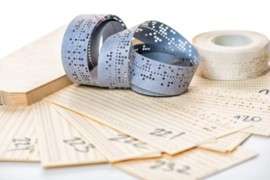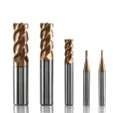Introduction
In this article, based on the basics of CNC machining, we shall introduce the points of cost-effective machined parts that beginner mechanical designers tend to fall into.
Let me tell you about the part where you can do things cheaper with cutting. When you think of machining, you may have an image of all the rough, inorganic parts for industrial products, but in fact, you can actually create a variety of shapes, such as twisting curved surfaces.
This time, we will introduce various “wonderful shapes” while introducing the process of realizing complex shapes by cutting with the current computer control.
What is NC processing?
Although it has been mentioned many times, cutting is a process in which a rotating blade is pressed against a material along a set trajectory to scrape it off and remove unnecessary parts.
So what does “along a set trajectory” mean?
I’ve left the expression vague so far, but it’s a very important part of cutting, so I’ll explain it in a little more detail.
Let’s put aside general-purpose machine tools that are “manually operated” such as general-purpose milling cutters for the time being, and talk about so-called “automatically-operated” NC machine tools such as NC milling cutters and machining centers.
In such machines, the blades that cut the material are moved by the command language to the machine. When you input the command “Move the end mill to this position” into the machine, the machine automatically moves according to the command. The position of the end mill is expressed by each numerical value of X, Y, and Z. Machining proceeds by moving these values according to the program.
What is an NC milling cutter?
The “NC” in NC milling cutter stands for “Numerical Control”. “X” is the “horizontal direction”, “Y” is the “back and forth direction”, and “Z” is the “vertical direction”. By continuously inputting the “next position to move”, it is possible to move the end mill by drawing smooth curves and complex trajectories
Conversely, the machine only operates according to the input instructions. The final shape depends on the input NC program. Before the development of computers, it seems that NC programs were stamped on special paper tapes and passed through a machine to read them. This seems to be the reason why veteran craftsmen refer to NC programs as “tapes.”
NC programs on special paper tapes
Currently, we handle NC programs as computer data. The NC program is stored as data in the machine’s memory, and while reading it line by line as instructions, it operates according to the contents of the instructions.
The Configuration of NC Program
An NC program basically has a common configuration for any machine tool. “The part that controls the movement of the machine” such as “G code” or “M code” that rotates the spindle or changes the movement speed, and the “end mill tip position” as the X, Y, Z coordinate values it consists of a combination of the part that gives the command value.
Modern cutting using computers: CAD/CAM
Simple NC programs such as “just drill a hole” or “just move the blade in a straight line” can be easily created, but complex NC programs such as “cutting a curved surface” require the engineer’s brain. It goes beyond the level of thinking and typing by hand.
The so-called CAD/CAM system comes into play in such situations. “CAD/CAM” is “Computer Aided Design” and “Computer Aided Manufacturing”, so basically it is a general term for “designing and manufacturing using computers”.
Currently, in a narrow sense, CAD refers to software that creates drawings and 3D models on a computer, and CAM refers to software that creates NC programs using CAD data. Even creating complex NC programs requires computer assistance. Some software has both CAD and CAM functions, and there is also software with independent functions.
Determine The Appropriate Process for the Machining
CAD has been covered in detail on various sites, so here I will explain in a little more detail about CAM, which designers are not often aware of. In the NC program creation process using CAM, it is necessary to determine the appropriate process, the type of end mill, and the machining conditions based on the material and shape of the workpiece, and input them as information.
There are countless options that can be taken depending on the material and shape of the material, the order of setup, etc. What kind of settings to make depends largely on the experience and sense of the engineer.
For example, there are many ways to fix materials. It can be clamped with a precision mechanical vise, directly fixed with a jig, fixed with a screw, etc. There are various options depending on the shape and process. It must be set according to all setups and types of end mills and converted to NC programs.
Application of End Mills in Cutting Curved Surfaces
There are various types of end mills, such as ball end mills that are suitable for cutting curved surfaces with rounded ends, flat end mills that are suitable for cutting straight flat surfaces, and drills for drilling holes.
various types of end mills
Each type is divided into various shapes such as the diameter, the number of blades, and the effective length of the blade. Set what kind of machining method and what kind of machining conditions to use for each end mill.
Even end mills are not limited to one type for one setup. Rather, it is not uncommon to use dozens of types. Then the parameters to set become huge.
What are the machining conditions for making cheaper complex parts?
Machining conditions include the number of rotations of the spindle, the speed of movement, and the amount of material to be removed. There is an optimal combination depending on the end mill shape, material, and material of the material. The question is how to derive the optimum combination, prevent wear of the end mill, and shorten the machining time.
An excellent NC processing engineer creates an NC program in the shortest possible time under the cutting conditions that cause chattering. While taking into account the recommended conditions of the blade manufacturer and my past experience, I set the image of the processing state in my head.
Imagining the sounds and vibrations of carving in my head, I imagine things like, “This condition is too fast,” or “I wonder if I can cut a little deeper.” It’s exactly part of professionalism. This combination of processes and NC programs can cut machining time in half or even a quarter.
You can do it! “Three-dimensional shape by cutting”
Now, let’s take a look at some examples of how CAD/CAM can be used to create NC programs that would otherwise be impossible and to create shapes that are more complicated than you might imagine.
Representative of 5-axis machining: impeller
A typical example of a part that can only be achieved by so-called simultaneous 5-axis machining is the “impeller” used in automotive turbochargers.
Without CAD/CAM, the NC program for cutting the intricate parts of this impeller would not be possible. It’s because it’s shaped like a lump of the undercut.
Simultaneous 5-axis machining can only be achieved by the complex movements of the table surface (A-axis, B-axis) on which the material is placed and the end mills (X, Y, Z) linked together.
Contemporary Sculpture: 3D Modeling
As long as you have a 3D model, you can semi-automatically generate NC data for cutting the shape with CAM. Therefore, it is possible to realize all three-dimensional shapes, including sculptures such as statues and figures. Of course, it is necessary to consider the corner R and undercut that I have introduced so far.
The shape can be reproduced faithfully to the 3D model. Some of our customers are thinking of cutting out famous characters by machining and selling them as ultra-luxury objects.
Make cutting work more familiar!
Machined parts come in a variety of shapes depending on the application, but no matter how complicated the shape may be, it can be machined as long as the corner R and undercut are taken care of.
You might think that casting is the best way to mass-produce a more complex shape, but there are many advantages to machining. Porosity, which tends to be a problem in casting, can be avoided, and since there is no need to manufacture molds, initial costs can be reduced, and delivery can be shortened.
Summary
I would be happy if you could keep the use of cutting in mind even for mass-produced processed parts. The total cost is surprisingly low, and there is also the advantage of being able to respond flexibly to design changes.
We hope that this article will help you to feel more familiar with machining and to broaden your design horizons.










0 Comments